Game On!
The Honda CR-V is Honda’s best-selling model in America, and it’s sold more than five million since its debut in 1997, more than any compact crossover. With the CR-V accounting for more than 60 percent of Honda’s SUV sales, you can be certain they will only make changes to it designed to increase its sales. So what have they done? How about adding two electric motors to the already efficient gasoline motor, creating the first-ever CR-V hybrid. The all-new 2020 Honda CR-V Hybrid AWD hit showrooms on March 1 with a starting price of $27,750.

With the Toyota RAV4 Hybrid and Ford Escape Hybrid already in dealerships (and the Nissan Rogue Hybrid there and gone), Honda could be considered late to this segment of hybrid all-wheel drive compact crossovers. But have no doubts about its intentions. In Honda’s mind it is Game On!–and they plan on retaking the overall sales status and not looking back.
Electrification Makes the Difference
The Honda CR-V Hybrid is powered by an efficient 2.0-liter four-cylinder, Atkinson-cycle gasoline engine, with twin electric motors. One motor can drive the car a limited distance on pure electricity, and the other powers an electric generator or the battery pack as a series hybrid. It also operates as a parallel hybrid when the engine is running at highway speeds. The total 212 horsepower (hp) and 232 pound-feet (lb.-ft.) of torque, are considerably more than the gasoline-only CR-V which has 190 hp and 179 lb.-ft. of torque. Available only with all-wheel drive, the 2020 CR-V Hybrid eschews a conventional transmission, instead using Honda’s fixed ratio Real Time AWD with Intelligent Control System that primarily drives the front wheels. The computer automatically and seamlessly sends electric power to the rear wheels as needed.

The engine was mildly noisy during stress, such as aggressive acceleration or climbing a grade, but quiet and smooth in highway cruising or in-town driving. Steering-wheel mounted buttons can be used to slow the car, providing three levels of regeneration. Pushing the left-side button one, two or three clicks provides additional electric regeneration to the lithium-ion battery, which is charged when applying the brakes or coasting. The regenerative charging system converts kinetic energy into electric energy and stores it in the battery, a process viewed on a dash gauge, where you can watch the power flow into and out of the battery, motors and engine. Pressing on the right-side button reduces the regeneration level. Most systems like this use paddles located behind the steering wheel, but the button approach was equally user-friendly and effective.
Hitting the Open Road
Clean Fleet Report spent a few days in Tucson at the North American press launch of the 2020 Honda CR-V Hybrid. After a technical briefing, journalists were paired-up and set out on a planned drive through the desert. Honda’s goal was to showcase the driving attributes of the CR-V Hybrid through city stop-and-go traffic, and then on the open road.

The EPA fuel economy is rated at 40 city/35 highway/38 combined. Our 81-mile drive, in the CR-V Hybrid AWD, returned an average of 41.25 miles per gallon which was a nice improvement over the EPA rating. The three, driver-selectable drive modes of Econ, Sport and EV are self-explanatory, providing a choice of maximizing fuel economy, performance, or using no gasoline at all. For comparison, the gasoline-only CR-V AWD is rated at 27/32/29.
To really test the hybrid technology, we decided to climb Mt. Lemmon, the highest peak in the Santa Catalina Mountains that surround Tucson. We climbed approximately 7,000-feet in 20 miles, at about 55 mph, to the 9,100-foot summit. To do this, we were using the electric motors exclusively, experiencing the torque and power to their fullest. The climb was steady and smooth, with only the occasional slower car or motorhome impeding our speedy run to the top.

The CR-V Hybrid handled well on the curvy, fast corners. We were driving the CRV-Hybrid Touring, which had 235/60 all-season tires on 19-inch wheels. The traction was good with little tire slippage under hard cornering stress. There was mild body lean, but mid-corner corrections were not necessary, even when pushing through the twisties. For a vehicle not designed or marketed as being ‘sporty,’ the CR-V Hybrid held its own quite nicely. Just for fun, we reset the mileage/fuel economy meter to see what we could achieve by descending several thousand feet in elevation. We went 39.2 miles, from the snow at the top of Mt. Lemmon to our desert-based hotel, with an average of 90.3 mpg. Now that is fantastic fuel economy!
Pleasing Exterior/Welcoming Interior
Now in its fifth generation, the 2020 CR-V is the middle child of Honda’s four crossover SUVs, big brother to the HR-V and smaller sibling to the Passport and Pilot. With a safe design, there are no radical elements that scream “Look at me!” But none of that is bad, as Honda’s designers created a smooth, pleasing look with few abrupt edges. The body color-keyed bumpers, door handles, shark fin antenna and exterior mirrors were offset by black front and rear fascias and a minimalist’s tasteful use of chrome.

Climb inside for a welcoming experience. Clean Fleet Report test drove the CR-V Hybrid Touring with seats trimmed in leather. The driver and passenger seats are heated, and the driver gets 12-way and the passenger four-way power adjustments. The driver thankfully got lumbar adjustments.
The cockpit design is driver-friendly with a digital dash and infotainment systems ranging from 180 watts and eight speakers to a whopping 330 watts and nine-speakers. The 7.0-inch, high-resolution color touchscreen housed the radio, SiriusXM, Apple CarPlay and Android Auto. The only thing lacking was a channel selection knob, which would have accompanied the volume knob to make the system even more user-friendly. Overall, the build quality was at a high level with soft surfaces on the dash and door panels, complemented by stitching and wood grain accents throughout the cabin. The shift-by-wire gear selector in the center console eliminates a conventional space-grabbing shift lever.
The rear seats are made for grown humans–two comfortably, but three for short jaunts. There is a low sill step-over, which was nice. The rear seat itself, divided by the fold-down armrest with cup holders, had ample leg, shoulder and head room. Honda was quick to point-out the rear leg room was “top in class compared to other compact hybrid-electric crossovers.” For storage, the rear seat folds 60/40 to provide top-in-class cargo space.
Safety

Beginning in 2020, all CR-V models come standard with active and passive safety features such as front and side air bags and Honda Sensing, the company’s advanced driver assistance systems (ADAS) safety technologies, which include forward collision and road departure mitigation, lane keep assist and adaptive cruise control.
Pricing and Warranties
The 2020 Honda CR-V Hybrid AWD comes in four trim levels of LX, EX, EX-L and Touring, with base pricing ranging from $27,750 to $35,950. All pricing excludes the $1,120 destination fee.
All 2020 CRV-Hybrid models come with these warranties.
- Hybrid Components – Eight years/100,000 miles
- Powertrain – Five years/60,000 miles
- Basic – Three years/36,000 miles
- Anti-perforation – Five years/Unlimited miles
- Roadside Assistance – Three years/36,000 miles
Observations: 2020 Honda CR-V Hybrid AWD
The 2020 Honda CR-V Hybrid AWD has been long-awaited in America, as it has been available in Japan and the UK for at least a year. But it is never too late to introduce an electrified model, especially in the hot crossover segment. This won’t be the last such vehicle from Honda, as it has set a goal that by 2030 two-thirds of global vehicle sales will be electrified.
With final assembly in Greensburg, Indiana, this extremely economical vehicle should cover all your driving needs, whether it’s commuting, in-town errands or long road trips.

Treat yourself to a lengthy test drive at your Honda dealership, and see for yourself how the CR-V Hybrid AWD will ease your daily driving and be easy on your fuel budget.
Make sure to opt-in to the Clean Fleet Report newsletter (top right of page) to be notified of all new stories and vehicle reviews.
Whatever you end up buying, Happy Driving!
Related Stories You Might Enjoy—The Hybrids & Other Compact Competitors
Flash Drive: 2020 Ford Escape Hybrid
Flash Drive: 2020 Hyundai Nexo Fuel Cell Electric
Road Test: 2019 Toyota RAV4 Hybrid
Road Test: 2019 Subaru Forester
Road Test: 2017 Jeep Cherokee
Road Test: 2018 GMC Terrain
Road Test: 2018 Volkswagen Tiguan
Road Test: 2018 Mazda CX-5
News: Jeep Compass To Go Plug-in Hybrid
Road Test: 2018 Kia Sportage
Road Test: 2018 Mitsubishi Eclipse Cross
Road Test: 2018 Chevrolet Equinox
Road Test: 2017 Nissan Rogue Hybrid
Road Test: 2018 Mitsubishi Outlander Plug-in Hybrid
Disclosure:
Clean Fleet Report is loaned free test vehicles from automakers to evaluate, typically for a week at a time. Our road tests are based on this one-week drive of a new vehicle. Because of this we don’t address issues such as long-term reliability or total cost of ownership. In addition, we are often invited to manufacturer events highlighting new vehicles or technology. As part of these events we may be offered free transportation, lodging or meals. We do our best to present our unvarnished evaluations of vehicles and news irrespective of these inducements.
Our focus is on vehicles that offer the best fuel economy in their class, which leads us to emphasize electric cars, plug-in hybrids, hybrids and diesels. We also feature those efficient gas-powered vehicles that are among the top mpg vehicles in their class. In addition, we aim to offer reviews and news on advanced technology and the alternative fuel vehicle market. We welcome any feedback from vehicle owners and are dedicated to providing a forum for alternative viewpoints. Please let us know your views at publisher@cleanfleetreport.com.

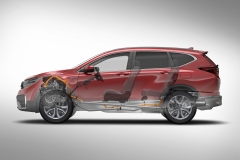
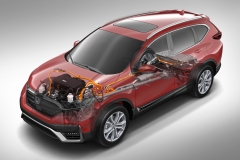

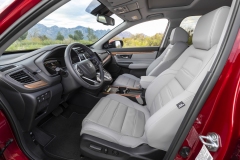

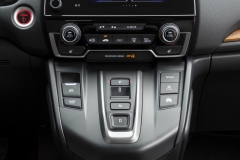
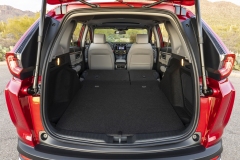
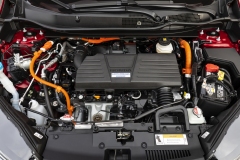
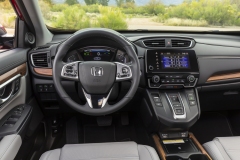
20 thoughts on “Flash Drive: 2020 Honda CR-V Hybrid AWD”